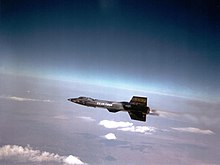North American Aviation
| North American Aviation, Inc.
|
|
|---|---|
| legal form | Acquired by Boeing in 1996 |
| founding | December 6, 1928 |
| Seat |
Los Angeles , United States |
| Branch | Aircraft construction |
North American Aviation, Inc. was a major US aircraft manufacturer . The company was founded in 1928 and bought by Boeing in 1996 .
history
When North American was founded on December 6, 1928 by Clement Keys in Delaware on the east coast of the USA, the company was a pure holding company with interests in various airlines and affiliated companies, including Eastern Air Transport . As a result of the airmail scandal of 1934 , these companies were banned from airmail transport, whereupon the group of companies sold its holdings in the airlines. North American subsequently became an aircraft manufacturing company under the direction of James Howard Kindelberger .
The General Motors Corporation took a controlling interest in the NAA and merged it in 1933 with the General Aviation Manufacturing Corporation, but retained the name North American Aviation at.
Kindelberger relocated the company headquarters to Inglewood (California), directly at Los Angeles Municipal Airport , because the good weather conditions made it possible to fly there all year round. Kindelberger promised itself a competitive advantage over other manufacturers.
In 1940, North American opened manufacturing facilities in Dallas, Texas and Kansas City, Kansas to manufacture military aircraft for the United States Army Air Forces during World War II . The AT-6 trainer aircraft was the first mass-produced type that pioneered North American production of the hugely successful P-51 Mustang fighter aircraft . The third type produced in large numbers by North American was the twin-engined B-25 bomber .
Even after the war, more military machines went into production. However, the order situation was too poor to be able to maintain the two plants in Dallas and Kansas. They were closed again. After series production of the F-86 Saber began in 1948, new plants were built in Columbus (Ohio) and Downey (California).
The rocket engine division became independent under the name Rocketdyne in 1955. In the same year, Atomics International was founded, a separate division for nuclear technology .
Once in the late 1950s, the orders for two other types of machines from the Ministry of Defense of the United States had been withdrawn, North American decided in the space program of NASA to enter. This awarded North American in Downey the contract to build the Command / Service Module (CSM) for the Apollo program . The propulsion system of the Redstone rocket and the second stage of the Saturn V were also manufactured.
After the Apollo 1 disaster on January 27, 1967, North American was blamed for much of the complicity as many negligence in execution was noted. The company then merged with Rockwell-Standard in September of the same year to form North American Rockwell , which in turn became Rockwell International in 1973. Finally, in December 1996 , Boeing bought Rockwell's military and space division.
Aircraft types
Fighter planes
bomber
Reconnaissance aircraft
Training aircraft
Test aircraft
Civil aircraft
- NAC-60 (draft)
Cruise missiles
literature
- PD Stemp: Kites, Birds & Stuff (Aircraft of the United States of America) - North American to Rockwell Aircraft + Aero Commander , ISBN 978-1-326-82815-8
Web links
Individual evidence
- ^ Pound, Arthur: The Turning Wheel; the Story of General Motors Through Twenty-five Years, 1908-1933 . Chapter XXIII - General Motors in Aviation.
- ^ Bill Yenne: The Story of the Boeing Company . Zenith Imprint, October 1, 2005, ISBN 978-0-7603-2333-5 , p. 134 (accessed February 5, 2013).









